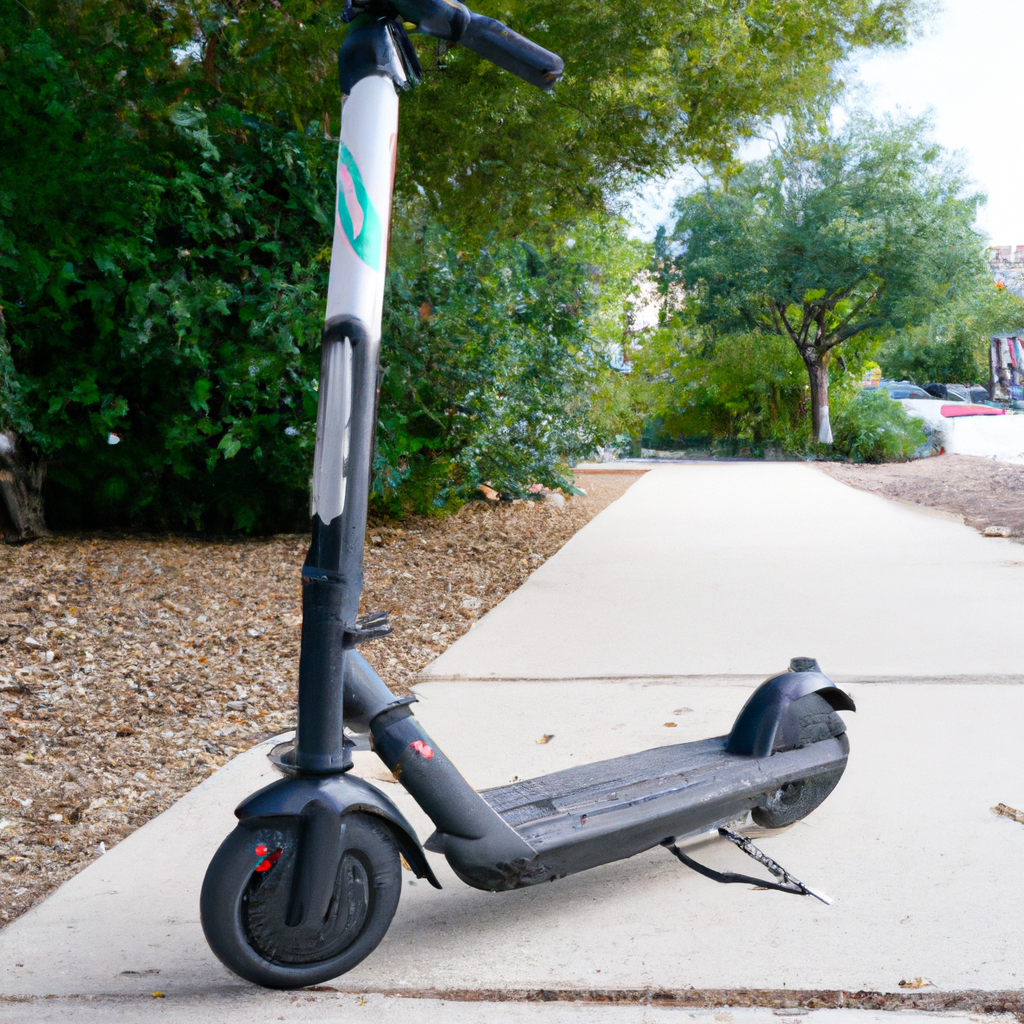So, you’ve recently noticed an increase in electric scooters buzzing around your city and you’re wondering, are they even legal? It’s a valid question, as the popularity of these compact and eco-friendly vehicles has soared in recent years. From zipping through traffic jams to effortlessly maneuvering through crowded sidewalks, electric scooters have become a convenient mode of transportation for many. However, before you hop on one and whisk yourself away into the sunset, it’s important to understand the laws and regulations surrounding electric scooters in your area. In this article, we’ll explore the legality of electric scooters and help you navigate the rules and restrictions that might be in place in your specific region.
Overview of Electric Scooters
What are electric scooters?
Electric scooters, also known as e-scooters, are personal transportation devices that are powered by an electric motor. They are similar in appearance to traditional kick scooters but are equipped with a battery and motor, allowing for easier and faster travel. Electric scooters have gained significant popularity in recent years as a convenient and eco-friendly urban transportation option.
Why are electric scooters gaining popularity?
There are several reasons why electric scooters are gaining popularity. Firstly, they provide a convenient and efficient mode of transportation, particularly for short distances. They are compact and lightweight, making them easy to maneuver through traffic and tight spaces. Electric scooters are also cost-effective, as they consume less energy compared to traditional vehicles and require minimal maintenance. Additionally, they are eco-friendly, emitting zero or minimal emissions, which helps reduce air pollution and alleviate traffic congestion.
Different types of electric scooters
Electric scooters come in various forms and designs, catering to different needs and preferences. Some popular types include:
-
Stand-up electric scooters: These are the most common type of electric scooters, resembling traditional kick scooters but with an electric motor and battery. Riders stand upright on a platform between the handlebars and control the scooter using a throttle and brakes.
-
Electric mopeds: These scooters are equipped with larger frames, seats, and more powerful motors. They often have a higher top speed and longer range compared to stand-up electric scooters.
-
Folding electric scooters: Designed for enhanced portability, folding electric scooters can be easily folded and carried or stored when not in use. They are popular among commuters who need to combine public transportation with scooting.
-
Electric scooter sharing: Many cities have introduced electric scooter sharing programs, where users can rent electric scooters through smartphone applications. These scooters are typically dockless and can be picked up and dropped off at designated locations.
Advantages of electric scooters
There are several advantages to using electric scooters as a mode of transportation. Firstly, they are cost-effective, requiring less fuel and maintenance compared to vehicles. Electric scooters also provide a faster and more convenient way to navigate through urban areas, particularly during peak traffic hours. Additionally, they contribute to reducing air pollution and greenhouse gas emissions, promoting a cleaner and healthier environment. Electric scooters are also a great alternative for short trips, saving commuters time and money while reducing traffic congestion.
Disadvantages of electric scooters
While electric scooters offer numerous benefits, there are also some disadvantages to consider. One significant concern is the safety of both riders and pedestrians. Electric scooters can reach high speeds, and riders may not always prioritize safety measures such as wearing helmets or following traffic rules. This can lead to accidents and injuries. Another disadvantage is the limited range and battery life of electric scooters. Depending on the model, scooters may have a maximum range of 15-30 miles before requiring a recharge. This can be a limitation for longer journeys or those who rely heavily on their scooters for transportation.
Electric Scooter Regulation and Enforcement
Current laws and regulations regarding electric scooters
The laws and regulations regarding electric scooters vary from country to country and even within different regions of the same country. At present, many cities and jurisdictions are in the process of developing regulations to address the rise of electric scooter usage. Some common regulations include age requirements, speed limits, and regulations related to sidewalk usage. In many cases, electric scooters are subject to the same rules of the road as bicycles or other low-speed vehicles.
Government agencies responsible for regulating electric scooters
The specific government agencies responsible for regulating electric scooters differ based on location. In the United States, for example, it may be a combination of local transportation departments and traffic safety agencies. In Europe, the responsibility may lie with national transportation agencies as well as local governments. These agencies are responsible for developing and implementing regulations, ensuring compliance, and addressing any concerns regarding the use of electric scooters.
Enforcement of electric scooter laws
Enforcement of electric scooter laws also varies depending on the jurisdiction. In some areas, law enforcement officials actively patrol and enforce electric scooter regulations, while in others, enforcement may be more lax or sporadic. However, as electric scooter usage becomes more widespread, authorities are placing greater emphasis on enforcing these laws to ensure public safety. Riders who violate regulations may face fines, penalties, or even have their scooters impounded.
Penalties for violating electric scooter regulations
The penalties for violating electric scooter regulations can vary depending on the severity of the violation and the jurisdiction. Common penalties may include fines, points on a driver’s license, or mandatory safety courses. In some cases, repeated violations may lead to the suspension or revocation of the rider’s license. Penalties are typically in place to encourage safe and responsible scooter usage and deter riders from engaging in dangerous or illegal behavior.

Electric Scooter Legality by Region
Laws regarding electric scooters in the United States
In the United States, electric scooter laws vary from state to state and even within different cities and municipalities. Some states have established clear regulations, while others are still in the process of developing legislation. For example, California was one of the first states to legalize electric scooters, treating them as bicycles and allowing their use on roads and bike lanes. However, cities within California have implemented their own rules and restrictions, such as speed limits and helmet requirements.
Regulations on electric scooters in Europe
In Europe, there is no single set of regulations governing electric scooters. Each country within the European Union (EU) has the authority to establish its own laws and guidelines regarding electric scooter usage. However, the EU has released guidelines to address issues related to safety, insurance, and infrastructure. Some countries, such as Germany, have implemented mandatory insurance for electric scooters, while others, like France, require riders to have a valid driver’s license.
Electric scooter legality in Asia
Asia is home to a significant number of electric scooter users, but the regulations regarding their usage vary widely across the region. For example, in China, electric scooters are widely popular and operate in a legal gray area, with sporadic enforcement of regulations. On the other hand, Japan has strict regulations in place, requiring electric scooter riders to have a license plate, insurance, and adhere to specific speed limits. Southeast Asian countries such as Singapore and Thailand have also implemented regulations to ensure the safe and responsible use of electric scooters.
Legislation in other regions
Outside of the United States, Europe, and Asia, the legislation surrounding electric scooters differs depending on the region. In some countries, electric scooters may be classified as motor vehicles, requiring riders to have a driver’s license and registration. In other regions, they may be considered bicycles or low-speed vehicles and subject to certain restrictions and regulations. It is essential to research and understand the specific laws and regulations in your region before using an electric scooter.
Electric Scooter Laws in the United States
Overview of federal regulations on electric scooters
At the federal level in the United States, electric scooters are mainly subject to local or state regulations rather than specific federal laws. The Consumer Product Safety Commission (CPSC) provides guidelines for manufacturers regarding product safety standards but does not have jurisdiction over the usage of electric scooters on roads or sidewalks. Federal agencies such as the Department of Transportation and the National Highway Traffic Safety Administration may provide recommendations and guidance to states and local governments regarding electric scooter laws.
State-level electric scooter laws in popular cities
Many popular cities in the United States have implemented their own electric scooter laws to address the growing popularity of this mode of transportation. For example, in Los Angeles, riders must be at least 16 years old, wear helmets, and use bike lanes wherever available. San Francisco, on the other hand, had temporarily banned electric scooter sharing programs before implementing a permit system and setting a maximum number of scooters per company. It is important for riders to be aware of the specific regulations in their city of residence or travel.
Specific rules and restrictions for electric scooters
In addition to state and city regulations, there are specific rules and restrictions that electric scooter riders must follow. Some common rules include:
-
Age requirements: Most jurisdictions require riders to be a minimum age, typically ranging from 16 to 18 years old.
-
Helmet usage: Many cities and states have helmet requirements, especially for riders under a certain age. However, even if not legally required, wearing a helmet is strongly recommended for safety.
-
Sidewalk usage: Some areas restrict or prohibit electric scooters from being ridden on sidewalks to ensure pedestrian safety. However, in other places, riding on sidewalks is allowed, as long as riders yield to pedestrians.
-
Speed limits: Certain cities and states have established speed limits for electric scooters, often ranging from 15 to 20 miles per hour.
It is crucial for riders to familiarize themselves with the specific rules and restrictions in their area to avoid legal issues and ensure their safety and the safety of others.

European Regulations on Electric Scooters
European Union guidelines for electric scooters
The European Union has released guidelines to address the increasing use of electric scooters within its member countries. The guidelines emphasize safety, including the use of helmets, lights, and reflective clothing. They also recommend the creation of infrastructure to support electric scooters, such as dedicated parking spaces and charging stations. The EU guidelines also highlight the importance of insurance for electric scooter users, specifically stressing the need for liability insurance.
Country-specific laws and regulations in Europe
While the European Union provides guidelines, each individual country within Europe has the freedom to establish its own laws and regulations regarding electric scooters. As a result, regulations may vary significantly from one country to another. For example, in Germany, electric scooters are classified as motor vehicles and require a registration plate and liability insurance. In contrast, countries like Belgium and the Netherlands treat electric scooters as bicycles, allowing riders to use bicycle paths and not requiring insurance or registration.
It is important for electric scooter users in Europe to research the specific regulations in their country of residence or travel to ensure compliance with the law.
Electric Scooters in Asian Countries
Laws on electric scooters in China
China is known for its high usage of electric scooters, which are mainly used as a popular mode of transportation. However, the laws regarding electric scooter usage in China are complex and typically enforced inconsistently. While riding electric scooters on the road is generally allowed, many cities have imposed restrictions on maximum speeds and require safety equipment such as lights and horns. In some areas, license plates and registration are mandatory, while elsewhere, enforcement may be more relaxed.
Regulations for electric scooters in Japan
Japan has stricter regulations when it comes to electric scooter usage. Electric scooters are considered motor vehicles and require riders to have license plates, insurance, and valid driver’s licenses. There are also specific speed limits and restrictions on where electric scooters can be ridden, such as designated lanes or roads. Japan places a significant emphasis on rider safety and has implemented comprehensive regulations to ensure responsible and legal usage of electric scooters.
Electric scooter policies in Southeast Asian countries
Southeast Asian countries, such as Singapore, Thailand, and Malaysia, have implemented regulations to balance the increased popularity of electric scooters with the need for safety and order on the streets. Singapore, for instance, has designated specific areas and pathways for electric scooter usage, while also imposing speed limits and requirements for registration and insurance. In Thailand, electric scooters are classified as motor vehicles, requiring licenses, registration, and adherence to traffic regulations.
Each country in Asia has its own approach to regulating electric scooters, and riders should familiarize themselves with the specific regulations in their region to ride safely and legally.

Safety Considerations for Electric Scooters
Tips for safe riding
To ensure a safe and enjoyable riding experience, electric scooter riders should consider the following tips:
-
Wear a helmet: Wearing a helmet is one of the most crucial safety measures. It protects the head in case of accidents and helps reduce the risk of head injuries.
-
Know the laws: Familiarize yourself with the laws and regulations governing electric scooter usage in your area. This includes speed limits, prohibited areas, and safety requirements.
-
Follow traffic rules: Treat your electric scooter like any other vehicle and obey traffic laws. This includes stopping at red lights, using turn signals, and yielding to pedestrians.
-
Be visible: Use lights and wear reflective clothing to increase your visibility, especially when riding at night. This ensures that other road users can see you clearly.
-
Be cautious of road conditions: Watch out for hazardous road conditions such as potholes, gravel, or wet surfaces. Adjust your speed accordingly and maintain a safe distance from other vehicles.
Protective gear for electric scooter riders
In addition to wearing a helmet, electric scooter riders may also benefit from wearing other protective gear to enhance safety. This includes:
-
Knee and elbow pads: These help protect joints from injury in the event of a fall or collision.
-
Gloves: Gloves provide better grip on the handlebars and protect hands in case of an accident.
-
Reflective clothing: Wearing bright or reflective clothing helps increase visibility, especially during low-light conditions.
While not legally required in all jurisdictions, wearing protective gear can significantly reduce the risk of injury while riding an electric scooter.
Common accidents and injuries associated with electric scooters
Electric scooters have been associated with several types of accidents and injuries, including:
-
Collisions with pedestrians or other vehicles: Due to their speed and sometimes unpredictable maneuvering, electric scooter riders can collide with pedestrians or other vehicles, leading to injuries for all parties involved.
-
Falls caused by road hazards or obstacles: Uneven surfaces, potholes, or unexpected obstacles can cause scooter riders to lose balance and fall.
-
Injuries from lack of protective gear: Riding without a helmet or other protective gear can increase the risk of head injuries, broken bones, and road rash in the event of an accident.
-
Accidents due to rider error or recklessness: Electric scooter riders who fail to follow traffic rules, ride at excessive speeds, or engage in reckless behavior increase the likelihood of accidents and injuries.
Responsibilities of electric scooter riders
Electric scooter riders have the responsibility to ensure their safety and the safety of others while on the road. This includes:
-
Adhering to traffic rules: Riders should follow traffic laws, including speed limits, stopping at red lights, and using appropriate hand signals.
-
Yielding to pedestrians: Electric scooter riders should yield to pedestrians and give them the right of way.
-
Riding in designated areas: Wherever possible, riders should use designated bike lanes or areas specifically allocated for electric scooters. Riding on sidewalks or in areas where it is prohibited can endanger pedestrians.
-
Park responsibly: Riders should park their electric scooters in designated areas or in a manner that does not obstruct pedestrian walkways or create hazards.
By taking these responsibilities seriously, electric scooter riders can contribute to a safer and more harmonious road environment.
Efforts to Update Electric Scooter Laws
Advocacy groups pushing for changes in regulations
Advocacy groups around the world have been actively pushing for changes in electric scooter regulations to better accommodate and promote this mode of transportation. These groups aim to increase accessibility, improve safety measures, and clarify legal ambiguity surrounding electric scooters. They work with policymakers, local governments, and transportation agencies to propose changes and updates to existing regulations, keeping in mind the best interests of electric scooter riders and the wider community.
Proposed legislation to address electric scooter legality
In response to the evolving landscape of electric scooter usage, lawmakers have proposed various pieces of legislation to address the legality and regulation of electric scooters. Some proposed measures include clearer definitions of electric scooters within existing transportation legislation, standardized regulations across cities and states, and increased enforcement of existing laws. Proposed legislation also aims to address safety concerns and ensure that electric scooters are integrated smoothly and safely into existing transportation systems.
Challenges in updating electric scooter laws
Updating electric scooter laws can pose several challenges. Firstly, there is the issue of regulatory fragmentation, with differing regulations in different cities or regions within the same country. This lack of uniformity can lead to confusion and inconsistency. Additionally, the rapid growth of the electric scooter industry has caused some concern regarding safety, enforcement, and the integration of scooters into existing transportation infrastructure. Balancing the interests of electric scooter companies, riders, pedestrians, and other road users is another challenge faced by policymakers as they update regulations.

Future of Electric Scooter Regulations
Anticipated advancements in electric scooter laws
As the use of electric scooters continues to grow, it is expected that regulations will evolve to address any existing gaps. Anticipated advancements in electric scooter laws may include:
-
Standardization of regulations: Efforts may be made to standardize regulations across cities, states, and even countries to create a more consistent legal framework for electric scooter usage.
-
Enhanced safety measures: Stricter safety requirements, such as mandatory helmet usage and safety education programs, may be implemented to improve rider safety.
-
Infrastructure improvements: Investments in dedicated electric scooter lanes, charging stations, and parking facilities can help integrate electric scooters into existing transportation systems more effectively.
-
Technology integration: Advances in technology may lead to the development of smart features, such as geofencing and speed limit enforcement, to enhance safety and adherence to regulations.
Potential impact of electric scooter sharing programs
Electric scooter sharing programs, where users can rent scooters on-demand through smartphone applications, have gained significant popularity in recent years. These programs have the potential to positively impact electric scooter regulations by:
-
Increasing accessibility: Electric scooter sharing programs make it easier for individuals to access electric scooters without needing to own one, making this mode of transportation more accessible to a wider population.
-
Raising awareness: Through electric scooter sharing programs, more people are exposed to the benefits and challenges of electric scooter usage. This increased awareness can drive policymakers to update regulations and address any issues that may arise.
-
Data collection: Electric scooter sharing companies have access to valuable data on rider behavior and usage patterns. This data can be used to inform policymakers and help them make informed decisions regarding regulations and infrastructure development.
Environmental considerations in future regulations
As the world grapples with the challenges of climate change and increasing pollution, electric scooters present a potential solution for sustainable and eco-friendly transportation. Future regulations may place a stronger emphasis on the environmental benefits of electric scooters, encouraging their use and promoting clean transportation. This could include incentives for electric scooter adoption, such as tax credits or financial assistance, as well as the promotion of renewable energy sources for charging electric scooters.
Conclusion
Electric scooters have revolutionized urban transportation, offering a convenient, cost-effective, and eco-friendly alternative to traditional vehicles. While regulations and laws regarding electric scooters vary across regions, efforts are being made to update and standardize legal frameworks to ensure safety and responsible usage. Riders should familiarize themselves with the specific regulations in their area, wear protective gear, and prioritize safety to prevent accidents and injuries. As the popularity of electric scooters continues to grow, advancements in regulations, increased safety measures, and environmental considerations are expected to shape the future of electric scooter laws.




